Magic is fake. Everyone knows this. The rabbit waits under the table, the card is forced. There are bogus thumbs, palmed coins, false-bottomed cups. Movies are also just pretend, tricks of light and sound. Computer graphics, A.I. technologies, even a clever camera angle can counterfeit just about anything. Magic on film? That’s a double fake, a disaster. Or it should be.
Yet the magicians of “Now You See Me,” the improbable 2013 magic-action-thriller-comedy-heist flick, and its 2016 sequel, “Now You See Me 2,” have now returned for a third film, “Now You See Me: Now You Don’t.” Tada! As a villain in this new film declares, magic is camp, pure cheese. Can camp and cheese really sustain a franchise? Did audiences really clamor for a third film (in theaters) introducing more magicians, more razzle-dazzle and a room that turns upside down? Apparently, yes.
Edward Ricourt, one of the writers of the first movie, has a theory for why it all works. “We want to be fooled,” he said during a recent video call.
Ricourt, a Manhattan native, grew up watching street performers in Washington Square Park and Central Park. Later, as a fledgling screenwriter in the early days of Occupy Wall Street, he began to imagine a script in which street magicians teamed up for a Robin Hood-style heist plot with magic as both the means and the misdirection.
Ricourt didn’t know that much about magic so once the script was written, in collaboration with Boaz Yakin and Ed Solomon, magic consultants were hired to flesh out tricks that could be integrated into the script. These consultants also came to New Orleans to teach some tricks to the actors: Jesse Eisenberg as an illusionist, Woody Harrelson as a hypnotist, Isla Fisher as an escapologist, Dave Franco as a sleight of hand expert.
Filming that magic was its own trick. At a traditional magic show, the audience observes from one angle only. In the movies, a camera roves. “You can see the strings and the wires and trap doors,” Bobby Cohen, a producer on the films and a former child magician, said on a video call. “So it was a lot of experimentation, a lot of rehearsal.”
While the first movie did use computer graphics to enhance tricks, Cohen insisted that it used them sparingly, to paint out those strings and wires. “But the principle of the trick, the way that a magician would do that trick onstage, it’s the same,” Cohen said. (The New York Times critic Stephen Holden was more skeptical, describing the movie’s tricks in his review as executed “without missing a beat but with a lot of help from computer-generated effects.”)
Computer graphics are excellent these days. Perhaps too excellent. An audience can sense when something is too clean, too perfect, Cohen argued. The goal for the films is to make the magic real — in other words, fake, but in an ordinary, tactile, human way. The fooling would play fair. And toward the close of the movie, there were scenes that showed how the tricks were done, deliberately demystifying the magic and letting the audience in on the ruse.
The first movie was a surprise success, earning more than $350 million worldwide. A sequel was quickly commissioned, as was a third film, though false starts stalled it for several years. Some of those false starts owed to performance anxiety. Each movie had to top the tricks of the last, but how do you top what’s already impossible?
“To justify a third movie, you have to give it a reason for being,” Ruben Fleischer, who came on as the director of “Now You See Me: Now You Don’t,” said on a video call. “Part of that was more spectacle, bigger twists, new cast.” Presto!
In addition to the original quartet, and Lizzie Caplan, who came on for the second movie, this third movie adds three younger magicians — Ariana Greenblatt (“Barbie”), Dominic Sessa (“The Holdovers”) and Justice Smith (“Jurassic World: Fallen Kingdom”). And according to Fleisher, it relies less on computer imagery than its predecessors.
“When you go to a magic movie, you want to appreciate that it’s real magic,” he said.
For this film, Fleisher brought on Randy Pitchford, a legacy magician and the owner of the famed magicians’ club the Magic Castle in Los Angeles. Pitchford in turn recruited Magic Castle regulars. As in the first film, they assisted the actors and helped to create illusions that would drive the story.
“We may have done our job a little too well, though, because there are shots in the film that look so freaking good that the audience is just going to assume it was done in C.G.,” Pitchford bragged on a video call. He and his colleagues helped to create a centerpiece of the movie, a chateau adorned with one room that flips upside down, another that resembles an M.C. Escher picture and a hall of mirrors. All of these were fully built, their effects achieved practically.
According to Cohen, the actors really do execute the tricks their characters perform. Sessa makes a card float. Franco throws several more. Eisenberg pulls off a vanish. Harrelson isn’t really a hypnotist, but in test screenings, many audience members all thought of the same card when his character fans out a deck onscreen. A promotional behind-the-scenes featurette shows the actors rehearsing the tricks.
These tricks weren’t so easy to learn. For the first movie, Fisher, who consulted with both a free diver and the magician David Blaine, learned to hold her breath for up to three minutes. Her tasks for this one might have seemed simpler: She palms a diamond and catches a card. But in reality, those actions were even harder to pull off. With the help of a consultant, she practiced for hours each weekend.
In a phone interview, Fisher said that magicians weren’t so different than actors. Both of them exploit human perception. “The difference is, when you do magic, it’s terrifying because of the actual practical skill of it,” she said. “But when I got there, when I got it right, it was a great feeling.”
That feeling, of a trick successfully executed, is the one these movies propagate. The viewers can delight in being fooled, savor how the fooling was done or simply surrender to a gape-mouthed sense of wonder.
Pitchford, who has a magician’s gift for ballyhoo, put it best: “It lets us, for a moment, feel what it would be like if this fantasy of magic could be true.”
Alexis Soloski has written for The Times since 2006. As a culture reporter, she covers television, theater, movies, podcasts and new media.
The post ‘Now You See Me: Now You Don’t’ Has Tricks Up Its Sleeve appeared first on New York Times.




